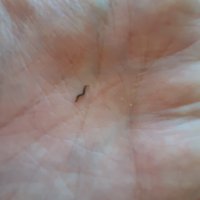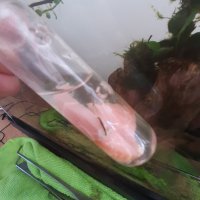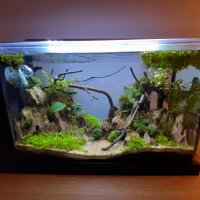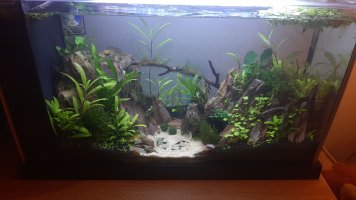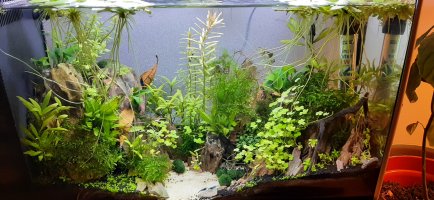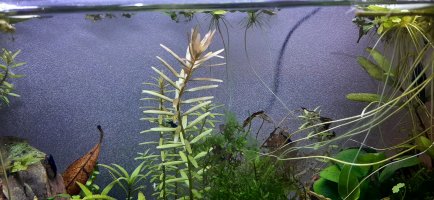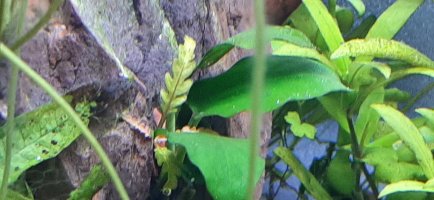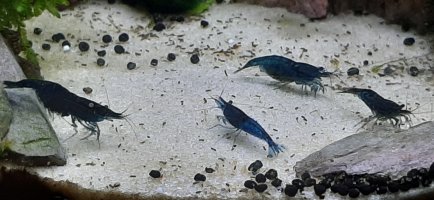Hello all,
This is gonna be a long one as it’s been a while. Sorry.
For anyone interested but who has the good sense to want just the bottom line without flushing ten unreclaimable minutes of their life away here‘s the bottom line;
The tank is basically ok.
I have fantastic Blue Velvet Neocaradina shrimp courtesy of Steve Buce.
There are ongoing issues with algae of various types and growth issues which I’m trying to be systematic in addressing.
The long term viability or this aquascape is beginning to be questioned.
I set up a second test tank to experiment with co2 which has been an unfocussed disaster.
I’m finding the constant scavenging for incomplete information combined with my inability to understand some profound concepts by turns frustrating and compelling.
I’m hoping the compelling continues to trump the frustrating but it’s a close call sometimes.
Done.
For a long ramble on the above plus pretty rubbish pictures see below;
Been quite a while since I updated this journal and looking back on it I can’t believe the energy and puppy-like enthusiasm I threw at this. The thrill of the new I suppose. I guess it’s still there but a little more tempered now. The rabbit hole just goes deeper and deeper but that’s a good thing. If one could just set up a tank and SHAZAM - lush plants like just out of the invitro jelly, aesthetic sensitivities of a renaissance architect who then became a Taoist monk and perfect knowledge of a super computer there would be no path, no development. The tank would be just another object on a sideboard, like another piece of tat to fill a gap. I have had a more than a few wobbles about all this planted tank lark though. No denying it. It might prematurely finish me yet, the combination of algae and incomplete science (applied) leaving me to only really able to rely on what I personally experience in an utterly subjective way.
Anyway, here’s a very boring picture.

Some while ago realised that despite this tank being in a nice spot to view and fettle with it was getting belted with direct and indirect sunlight from dawn until midday from east-facing windows (and lots of them). I knocked this together and have it in place during daylight hours. Ugly- yes, functional - mostly, in need of a long term upgrade - most certainly. What it should do is give me more control of what I understand to be one of the big three basic levers of tank balance. Since one of those levers in this tank appears to be fixed, i.e. this is a no-co2 supplemented tank, it seems quite important to have as much direct control over the remaining two as I can exert (wether or not I have the knowledge, skill and luck to apply those levers correctly is quite another matter of course ) An almost immediate reduction in the rate of algae on the glass resulted. It’s a faff - take it off, put somewhere out of the way, put in on......take it off, put.. etc but Mrs Big G wanted it within eyeshot of where we sit of an evening rather than have to make a point of visiting a distinct, less communal and possibly more remote spot. Fair enough. That spot comes with issues of fluctuating heat in summer as well of course.


So here’s the tank as it is more or less a few days ago.
Seems I’ve been subconsciously drawn to put together what I understand is called a diorama-style scape from what I can best judge. A mini recreation of a land-based vista? I believe these are not particularly sustainable long-term and mine has huge flaws and many mistakes on many levels. In no particular order and if I mush all the hundreds of hours of online videos and articles I’ve viewed together as best I can then accordingly I have infringed upon accepted wisdom in the following ways;
There isn’t enough stem planting space and/or nutrient containing substrate areas for substrate-based plants.
I did not include enough plants from the start either in terms of maximising the substrate areas I DO have nor the epiphetic-friendly spaces I could have used.
I thought I could ’grow in heavy’ rather than ‘plant in heavy’.
I didn’t design the layout well enough to contain terraced areas of aquasoil that didn’t slip or blend into areas lower down or into areas of cosmetic sand.
I thought I had a solution to stopping the blending of aquasoil with capping cosmetic sand in the context that I don’t actually really like very dark substrate visually as a top layer. I still don’t but the method I used was rubbish.
I planted and re-planted too much.
I used too much surface and water column grabbing hardscape (predominantly rocks).
I didn’t finalise the hardscaping and substrate layout before flooding the tank.
I (probably) used too much light from the start.
I fiddled around with flow rates and directions too much. Honestly? I am still struggling to find a flow method that balances the conflicting needs of surface adjutation for oxygen exchange and surface film dispersion with both water column flow and the floating plants’ desire (I believe) not to be circulated round the tank like a kid on a roller coaster.
I didn’t settle on a fertiliser dosing regime early enough. Again, to be fair, this remains an ongoing and entire set of side tunnels in the larger rabbit hole. Conflicting and incomplete information(perhaps just to me) doesn’t help.
There are probably more but that’s all I can think of for now. It all seems a little punishing when listed like that doesn’t it? I’m no masochist . Just being brutally honest with both myself and anyone who reads this that it might help too.
It is what it is though and you can see that design-wise the only rescaping has been to vacuum most of the sand off the aquasoil, vacuum the aquasoil off the middle beach area entirely and create aquasoil only and sand only areas. The only sand area is now the beach area in the middle. All of the netting I placed between the aquasoil and the sand originally has been removed.
Tank mods:
As a temporary measure to help the Salvinia out I’ve used the cut out rim of a plastic tub to float them in. It mostly works but is quite unnatural and a bit cheesy for my liking. It does seem to work though.
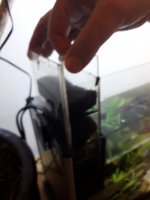
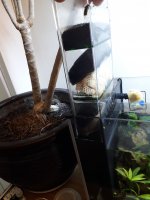
I splashed out on a filter chamber/media basket upgrade by Intank as I wanted to try and stop the shrimp from reaching the lower chamber area of the filter although by doing so they revealed the huge bypass issues with the original filter as well as the design limitations.
The Intake media basket is certainly an upgrade in terms of long term convenience and media customisation (which I haven’t properly ‘Pondguru’d yet as you can see). It didn’t solve the bypass issue fully nor foil the tenacity of the shrimp until I did this
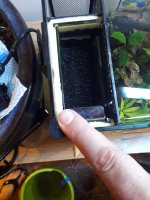
A bit of carefully cut sponge both means anything entering the chamber must now go down through the layered chambers serially. Having some of the original filter sponge cut to fit the top chamber means shrimp can use that area as a chill out room whilst they are small enough to fit through the grills but not venture down to the sump area. Trying to get a 4mm baby shrimp out of a small, long, dark sump chamber full of murky filter water is to be avoided.
The kit comes with a thin plastic piece that grips the acrylic media basket from hooks on the tank space and acts as a sort of grill restricter to increase kinetic flow into the top media chamber as well as hold the media basket flush against the wall. Well, maybe I’m missing a trick but the sponge I put in holds the basket flush and the restricted flow just channels the same amount of water through a smaller space imho. It also means that you have far less latitude in tank water level and far more quickly risk a situation where water pumped back into the tank exceeds that being ushered into the filter area. Since the filter area and pump areas are conjoined you could run the filter area and the pump area (which I have my heater in) dry at some point due to evapouration.
I really like it though but only with the mods Ive made. It’s got the original (now conditioned) Fluval biomedia in it , some cut up bits of the original sponge and a sachet of Purigen in. I’ll be adding a netted bag of Matrix and maybe some medium sponge ala Pondguru in due course. For the record, fine filter floss really restricts the draw of the pump and needs replacing every ten days or so.
Some Blue Velvet shrimp from Steve Buce (Thank you once again Steve. A true gentleman and man of his word) went in a while back and apart from one twenty four hour period where I lost about ten babies from the first berried female, for reasons unknown, they seem very healthy and happy. About eight of original crew appear to be in circulation at any one time (I have never seen a dead adult shrimp) and about ten of the babies range from 5mm to about 12mm and three more females are about to give birth. The shrimp have saved me from breaking the tank down on more than one occasion as I watch them Doozer around and have fun. Can’t see myself going back to fish at any point . Maybe a snail but fish, whilst very pretty seem to me to have less interesting behaviour- like a toy robot with limited programming somehow. Higher orders like Cribensis are a different matter. Shrimp really engage with every facet of the surfaces and crevices in their endless search for biofilm and mating opportunities.
Plantwise it’s currently the following;
Java moss - gone. A complete miserable nightmare of algae.
Flame moss - hanging in there on a twig but poorly after a heavy cut. Also a bit tied to a sliver of stone that just attracts, for want of a better term, grey dusty motes.
Weeping moss - just a bit tucked into a crevice. Neither grows nor dies. Same grey motes.
Spiky moss - seems to be actually growing well but also picks up grey motes.
Monte Carlo- it’s been in, its been out. It’s grown, its’s melted. I have only a little bit left very sparsely planted which is now just an experimental thing. Might root and make a carper in about 200 years at this rate.
Rotala rotundifolia - was growing ok but I moved some of it and took some of it for my experiment tank. It’s slowly coming back but doesn’t seem too healthy.
Hygrophilia Siamensis 53b- bought to replace the dreadful attempt at a moss tree back right and also to up my stem density. It’s ok. Growing slowly with huge deep roots in substrate. A bit yellow and gets brown algea on some of its leaves. Some placed front left to cover another design flaw in the layout.
Anubias Nana - puts the odd leaf out in each of its three locations but gets covered in shrimp waste and brown algae frequently. Its put out big feeler roots some of which I’ve left and some I’ve trimmed. Recently found that a microfibre cloth gets the brown stains off the leaves.
Microsorum pteropus ’narrow’ - bought to conceal a huge design flaw in my layout that could only be rectified with filter floss. It performs that function at the price of being too far forward in the layout. A few manky leaves but puts out baby plants frequently.
Sußwassertang/ Monosolenium Tenerum - gone. Another diatom magnet even in a tank that no longer lists diatoms amongst it’s list of unwanted organics. I understand this is one of those hard water things.
Bucephalandra micrantha ‘Needle leaf’ - bought along with a few other epiphytes to increase plant biomass retrospectively. Im warming to this little plant. Just gets on with it’s thing. A few leaves are dying but some other new ones are growing. Like it.
Hygrophilia Pinnatifida - same philosophy as with the buce but know this is a ’medium’ plant but thought I would try it as by all accounts there is enough PAR from the Fluval strip to be called a ‘medium’ light. Also by Tropica’s own Lumen per litre scale (just don’t get me started on my frustrations with the inadequacy of a reliable, scaleable, consistent measuring method of LED lighting as there is for say, T5HO

)there’s enough light. I think it’s dying...but just very slowly.
Hydrocotyle Tripartita ‘Japan’ same as the other two previous epiphytes I chose this off the back of an article by Dennis Wong in the belief its capable of being used in that way. It’s slowly going yellow in the positions I have it located held onto pebbles by cotton. Another ‘medium’ plant. I may actually try and treat some of this as a stem plant and see what happens. May only be epiphetic in high energy setups.
This whole (particularly LED) light and fertilisation area, which in a low tech planted tank are the only two levers I have as co2 is beyond my ability to influence, is just so indirectly, obliquely, conflictingly and cryptically talked about in everything Ive seen and read it makes me crave for a solid, old fashioned book which nails the whole thing down clearly and properly. The only other way is testing - trial and error, suck it and see. I’ll do that but I wish I had some clear, unambiguous, simple to follow methodology to kick off from. If I watch another gurning youtuber show me a tank full of immaculate plants and hardscape without explaining their rationale FULLY I shall need another computer

Whinge over
Current regime
shrimps get half a rice grains- worth of Bacter AE shaken in a test tube of tank water per day plus a tiny bit of various treat foods every 2-3 days in a glass dish that all but one or two show not the slightest interest in.
lights are currently running 6.5 hrs a day on a timer. No adjustment options
Ferts are 0.4mm TNC Complete per day as per just about the closest thing Ive found to some forthright advice in one of George Farmers videos which itself is based on the dosing regime he created for his Aquascaper complete liquid. Low tech 1ml per 50 litres per day. 20ish litre tank, bit less than half of 1mm. Dosed with a syringe. Daily is quite a bind so may drop that into two or three times a week instead. Total ferts per week seems to be more than TNC recommend but about half what a full EI- style regime for a high tech tank would be. I honestly just cannot fathom the whole ferts issue at this point. Too many questions and too many incomplete answers. Uh oh, whinging again

.
Algae- wise I had diatoms for about two weeks which I scrubbed and nipped out with pincers. Most of the Java moss got dumped in the diatom wave as it just couldn’t be teased out. Bleach and h202 treatments outside the tank just nuked it.
Currently got this grey/white dusty, fluffy stuff mainly on the mosses. I just shake the moss as best I can in the water column when I do a water change (40-50% once a week).
Got tiny green tufts with the odd filament strand on wood and rocks. I scrub the rocks with a toothbrush or interdental at WC time and pincer off the longer strands.
Got darker brown tufts with no filaments on rocks which I also scrub off at WC.
most weird is white, almost transparent hairs that almost look like fine nylon. Gets caught up in most of the plants. Spend hours removing with pincers. Too fine for cat or human hair. Real pain and very unsightly
plans
I’m toying with putting a Nerite snail in if I can get one but haven’t decided yet. I would rather not but it might be interesting.
The only real controls I have without resorting to chemical stop-gaps is lighting time and fertilisation.....and time. I’m going to try 7 hours a day light and keep everything else the same. I doubt the longterm viability of this scape but we’ll see. I may try and find space for another ‘easy’ stem that grows fast and I may double up on my floating plants as the Salvinia seems healthy but is not propagating very well.
all the best and sorry about the whinging. Bg.



